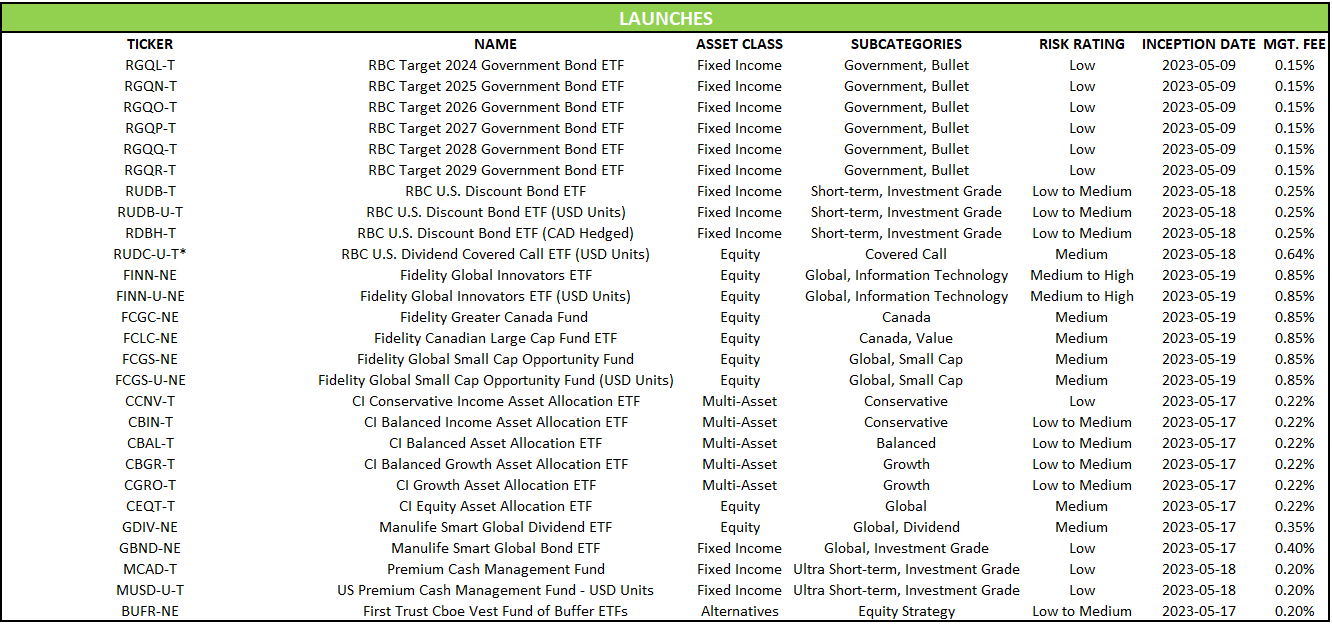In May, Canadian ETFs experienced inflows of $2.6B, with money market ETFs dominating the inflow, as has been the trend since the beginning of the year. Canadian Fixed Income ETFs received around $1.9B, contributing to a year-to-date total of approximately $9.2B out of the $15.3B inflow across all asset classes, as reported by National Bank Financial Markets.
Canadian equity ETFs led the way in terms of inflow, receiving around $0.6B, a significant improvement compared to last month’s outflow of approximately $0.8B. On the other hand, U.S. equity ETFs experienced a worsened situation with a money outflow of $0.5B, compared to last month’s $0.4B outflow. Looking at the overall year, international equity ETFs had the highest inflow, with approximately $4.7B, followed by Canadian equity ETFs at $1.6B, while U.S. equity ETFs suffered a net outflow of $1.5B.
The iShares MSCI Emerging Markets ETF (XEC) and BMO Equal Weight Banks Index ETF (ZEB) emerged as top performers in terms of inflow with $0.4B and $0.3B respectively. Conversely, the BMO S&P 500 Index ETF (ZSP) and BMO MSCI EAFE Index ETF (ZEA) experienced the worst outflows totaling $0.3B each.
In the month of May, a total of 27 new ETFs were introduced, the most since October 2022.
RBC launched ten new ETFs, six of which are part of the same group of bullet government bond ETFs representing the years 2024 to 2029 (RGQL, RGQN, RGQO, RGQP, RGQQ and RGQR). In addition, they introduced three ETFs (RUDB/RUDB-U/RDBH) that emphasize on tax efficiency and invest in short-term discount bonds in the United States. Among their new offerings, RUDC-U is a USD class of an existing covered call strategy that focuses on high-quality dividend-paying companies in the U.S.
Fidelity launched six equity-based ETFs. FINN/FINN-U focuses on innovative and disruptive companies around the globe. FCGC and FCLC invest in Canadian companies, but with the added flexibility to invest up to 49 per cent of their assets in foreign companies. FCGS/FCGS-U hold forty to eighty global small-cap stocks, an area where the managers consider they can more easily find mispriced opportunities.
CI Investments has introduced six new ETFs targeting investors with diverse risk appetites. The ETFs cover a range of asset allocations, starting from 80 per cent fixed income and 20 per cent equity, up to 100 per cent equity with a 20 per cent incremental change in asset allocation (CCNV, CBIN, CBAL, CGRO, and CEQT). However, CBGR offers a slightly different allocation of 70 per cent equity and 30 per cent fixed income.
Manulife recently introduced two new ETFs, the first one is GDIV which focuses on global dividend-paying companies by investing in various Manulife ETFs, including those from Canada, the U.S., and international markets. On the other hand, GBND primarily invests in investment-grade securities, aiming to optimize allocation across a variety of criteria such as sector, credit quality and maturity.
Evolve also launched two money market ETFs MCAD and MUSD-U providing cash alternatives to Canadian and U.S.-based investors respectively by investing in short-term maturity instruments from both government and corporate entities.
First Trust launched BUFR in Canada, an ETF that invests in other Equity Buffer ETFs. The primary objective of BUFR is to offer capital appreciation while providing downside protection.


Anthony Ménard, CFA, is vice-president of data management at Inovestor.
At Inovestor, we believe that investors deserve access to the best financial information available. Leveraging our suite of award-winning research technologies, we go above and beyond to put that information at your fingertips. For more information, please visit inovestor.com

